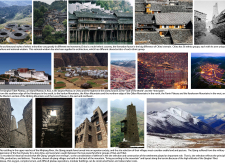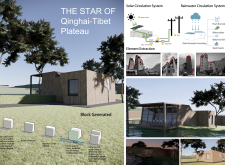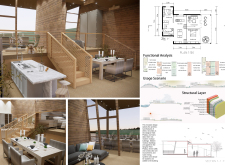5 key facts about this project
The architectural concept focuses on enhancing community engagement through the design of shared spaces that facilitate interaction among residents. The project carefully considers the high-altitude climate, utilizing materials and structural techniques suitable for the region, ensuring longevity and resilience.
Unique Modular Design Approaches
The modular design employed in this project allows components to be adjusted and arranged to respond effectively to the specific needs of the site and its users. The stacking of modular units is reminiscent of traditional Tibetan architecture, which maximizes functionality while fostering a strong sense of place.
One of the significant advancements in this design is the incorporation of local materials such as treated timber and reinforced concrete, which provide structural stability while also harmonizing with the surrounding landscape. The use of metal roofing materials not only caters to the climate but also enhances the building's durability. This strategic selection of materials demonstrates an understanding of both local customs and modern construction practices.
An innovative aspect is the integration of sustainable systems tailored to the environmental context. The project features a solar circulation system for harnessing renewable energy and employs a rainwater harvesting mechanism that supports irrigation and plumbing needs. These elements reflect a commitment to sustainable architecture, which is essential in the face of escalating climate concerns.
Community-Centric Spaces
The project's layout emphasizes community-oriented spaces that encourage social interaction. These areas have been designed to support gatherings, offer recreational opportunities, and promote a sense of belonging among residents. The configuration of the buildings allows for communal areas while ensuring privacy for individual units, balancing personal and collective needs.
This focus on community is further enhanced by the design’s responsiveness to the local topography. By orienting units to maximize views, sunlight exposure, and natural ventilation, the architecture creates a conducive living environment that promotes comfort and well-being.
The Star of Qinghai-Tibet Plateau exemplifies a comprehensive approach to modern architectural design that respects local heritage, prioritizes sustainability, and fosters community connections. For further insights into the architectural plans, sections, and design ideas of this project, readers are encouraged to explore the detailed project presentation, which highlights the technical aspects and design rationale.

























